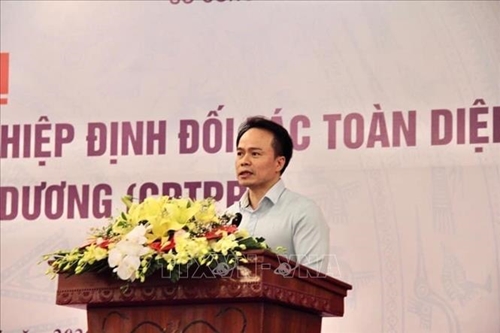As part of activities within MoIT’s plan for implementation of the agreement this year, the July 9-10 event offers a chance for businesses to find solutions to the difficulties they face on the threshold of deeper integration.
According to ministry figures, fewer than 40 of Vietnam’s 63 cities and provinces have trade relations with CPTPP member countries.
    |
 |
|
Deputy Head of the MoIT’s Multilateral Trade Policy Department Ngo Chung Khanh speaking at the event |
Ngo Chung Khanh, Deputy Head of the MoIT’s Multilateral Trade Policy Department, said the CPTPP opens up huge opportunities for Vietnam’s exports, but the country is yet to make full use of them.
Trade between Vietnam and CPTPP member countries hit 77.4 billion USD last year, up 3.9 percent year-on-year. Vietnam posted a surplus of 1.6 billion USD overall but a deficit of 900 million USD with these countries.
Participants at the conference have already focused on overviews of import and export taxes and instructions on how to identify and meet import and export tax commitments, rules of origin, and customs commitments in order to enjoy preferential taxes under the agreement.
Nguyen Son Tra, Deputy Head of the WTO and Trade Negotiation Division at the MoIT, told the gathering about CPTPP member countries’ import tax commitments.
Member countries have committed to eliminating tariffs on about 78-95 percent of the tax lines Vietnam is subject to. For common commodities, the road-map will take five to ten years. At the end of the roadmap, 98-100 percent of tax lines will have been eliminated.
Many of Vietnam’s key export items to the CPTPP are entitled to zero percent tax rates right after the agreement comes into effect or after three to five years, Tra said.
Participants have also focused discussions on services and investment, especially the obligations and basic principles of market opening, removing barriers facing services and investment, and commitments concerning investment promotion and protection.
The CPTPP, one of the largest trade pacts in the world, covers 13.5 percent of global GDP and a market of about 500 million people. It gathers 11 countries, namely Australia, Brunei, Canada, Chile, Japan, Malaysia, Mexico, New Zealand, Peru, Singapore, and Vietnam.
It officially took effect in Vietnam on January 14, 2019.
Source: VNA